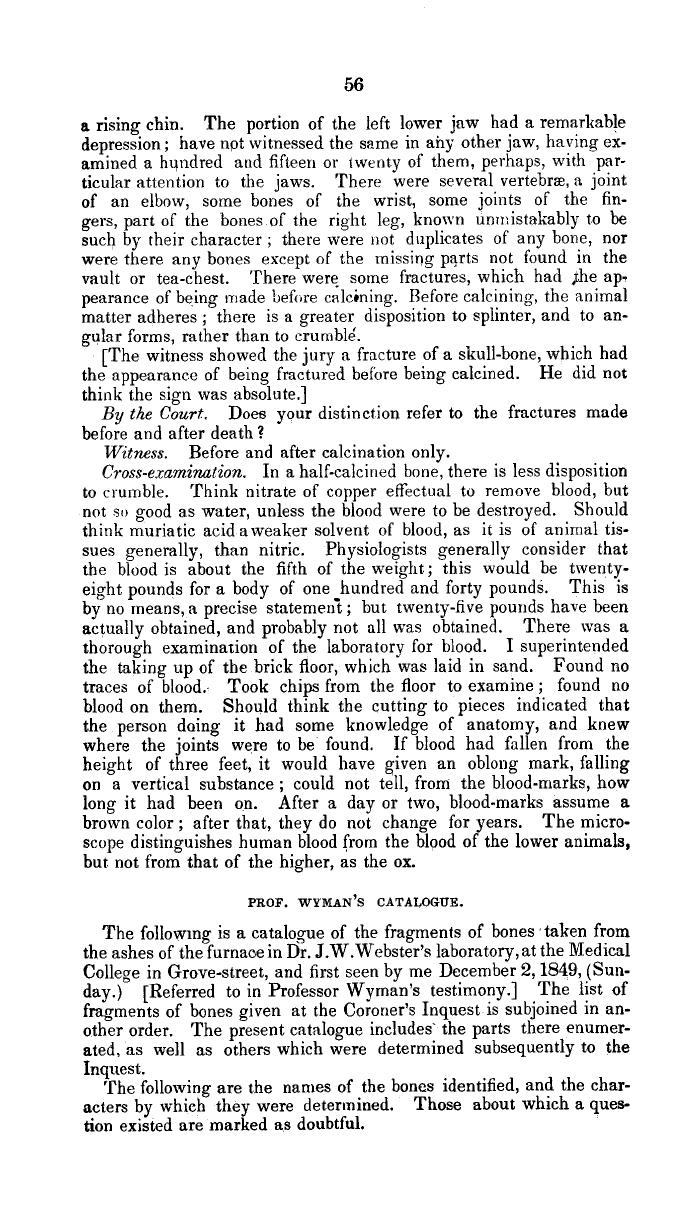|
56
a rising chin. The portion of the left lower jaw had a remarkable
depression; have not witnessed the same in shy other jaw, having ex-
amined a hundred and fifteen or twenty of them, perhaps, with par-
ticular attention to the jaws. There were several vertebra?, a joint
of an elbow, some bones of the wrist, some joints of the fin-
gers, part of the bones of the right leg, known unmistakably to be
such by their character ; there were not duplicates of any bone, nor
were there any bones except of the missing parts not found in the
vault or tea-chest. There were some fractures, which had the ap.
pearance of being made before calcining. Before calcining, the animal
matter adheres ; there is a greater disposition to splinter, and to an-
gular forms, rather than to crumble.
[The witness showed the jury a fracture of a skull-bone, which had
the appearance of being fractured before being calcined. He did not
think the sign was absolute.]
By the Court. Does your distinction refer to the fractures made
before and after death?
Witness. Before and after calcination only.
Cross-examination. In a half-calcined bone, there is less disposition
to crumble. Think nitrate of copper effectual to remove blood, but
not so good as water, unless the blood were to be destroyed. Should
think muriatic acid aweaker solvent of blood, as it is of animal tis-
sues generally, than nitric. Physiologists generally consider that
the blood is about the fifth of the weight; this would be twenty.
eight pounds for a body of one hundred and forty pounds. This is
by no means, a precise statement; but twenty-five pounds have been
actually obtained, and probably not all was obtained. There was a
thorough examination of the laboratory for blood. I superintended
the taking up of the brick floor, which was laid in sand. Found no
traces of blood. Took chips from the floor to examine ; found no
blood on them. Should think the cutting to pieces indicated that
the person doing it had some knowledge of anatomy, and knew
where the joints were to be- found. If blood had fallen from the
height of three feet, it would have given an oblong mark, falling
on a vertical substance ; could not tell, from the blood-marks, how
long it had been on. After a day or two, blood-marks assume a
brown color; after that, they do not change for years. The micro-
scope distinguishes human blood from the blood of the lower animals,
but. not from that of the higher, as the ox.
PROF. LAYMAN'S CATALOGUE.
The following is a catalogue of the fragments of bones taken from
the ashes of the furnace in Dr. J.W.Webster's laboratory, at the Medical
College in Grove-street, and first seen by me December 2,1849, (Sun-
day.) [Referred to in Professor Wyman's testimony.] The list of
fragments of bones given at the Coroner's Inquest is subjoined in an-
other order. The present catalogue includes' the parts there enumer-
ated, as well as others which were determined subsequently to the
Inquest.
The following are the names of the bones identified, and the char-
acters by which they were determined. Those about which a ques-
tion existed are marked as doubtful.
|

